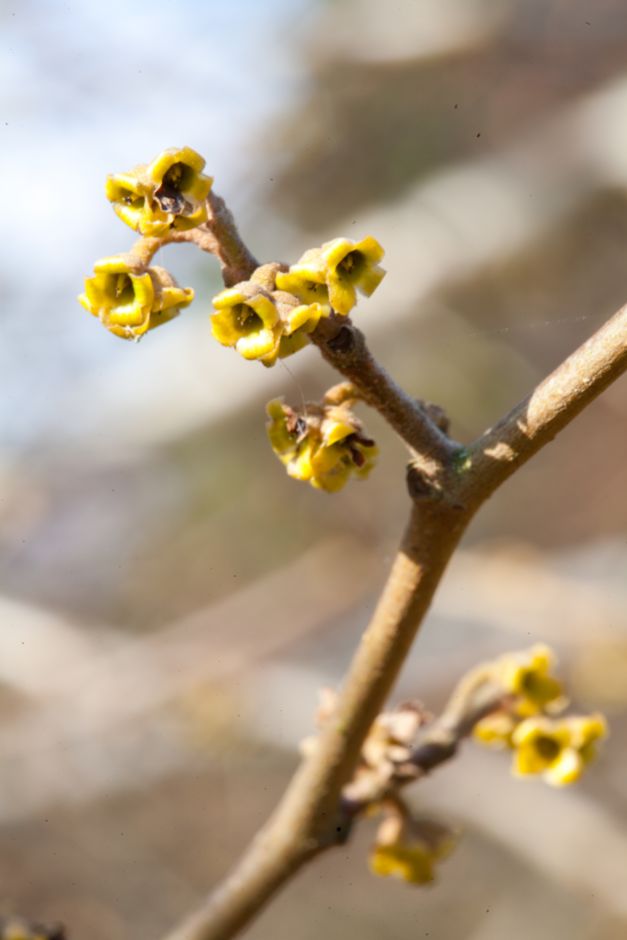Hamamelis virginiana
Virginian witch hazel
An erect large shrub up to 5m high (or occasionally a small tree up to 10m high) with smooth, broadly-oval, obovate, or nearly-round leaves, up to 15cm long, which open light green before becoming dark green. Clusters of sweetly-scented flowers with slightly-twisted, crimped, pale yellow petals, about 16mm long, appear from mid-autumn to late autumn, the flowers emerging while the leaves are still green and remaining as the leaves turn golden yellow and fall. H. virginiana is the species from which medicinal witch-hazel extract is made
Synonyms
Hamamelis androgynaHamamelis riparia
see moreTrilopus nigra var. catesbiana
Trilopus nigra
Trilopus riparia
Trilopus estivalis
Hamamelis virginica var. parvifolia
Trilopus rotundifolia
Hamamelis dioica
Hamamelis rotundifolia
Hamamelis corylifolia
Hamamelis estivalis
Trilopus virginica
Hamamelis nigra
Hamamelis virginiana var. orbiculata
Hamamelis caroliniana
Hamamelis parvifolia
Trilopus dentata
Hamamelis dentata
Hamamelis macrophylla
Hamamelis virginica var. macrophylla
Hamamelis hyemalis
Hamamelis virginiana var. parvifolia
Hamamelis communis
Trilopus parvifolia
Hamamelis virginiana var. angustifolia
Hamamelis virginica
Hamamelis monoica

Buy this plant
Size
Ultimate height
4–8 metresTime to ultimate height
10–20 yearsUltimate spread
2.5–4 metresGrowing conditions
Moisture
Moist but well–drainedpH
Acid, NeutralColour & scent
| Stem | Flower | Foliage | Fruit | |
| Spring | Green | |||
|---|---|---|---|---|
| Summer | Green | |||
| Autumn | Yellow | Gold Yellow | ||
| Winter |
Position
- Full sun
- Partial shade
Aspect
North–facing or South–facing or West–facing or East–facing
Exposure
Sheltered Hardiness
H6Botanical details
- Family
- Hamamelidaceae
- Native to GB / Ireland
- No
- Foliage
- Deciduous
- Habit
- Columnar upright
- Genus
Hamamelis are deciduous shrubs with broadly ovate or rounded leaves, sometimes colouring well in autumn, and fragrant yellow to red flowers with 4 narrow petals, borne on the leafless branches in late winter and early spring, or in autumn
- Name status
Correct
- Plant range
- E Canada, Midwest & East USA, Mexico
How to grow
Cultivation
Grow in moderately fertile, neutral or preferably slightly acidic soil which is well-drained but humus-rich and moisture-retentive in summer, in full sun or partial shade, in an open position with shelter from cold drying winds, and add mulch to conserve moisture; will also tolerate soils over chalk if they are deep and humus-rich; for more advice, see witch hazel cultivation
Propagation
Propagate by seed, sown in containers in a cold frame as soon as they are ripe (seeds may take two years to germinate), or by layering in autumn
Suggested planting locations and garden types
- Cottage and informal garden
- Low Maintenance
- Banks and slopes
- Hedging and screens
- Flower borders and beds
Pruning
Pests
Generally pest-free
Diseases
May be susceptible to coral spot, honey fungus, phytophthora root rot and powdery mildews
Get involved
The Royal Horticultural Society is the UK’s leading gardening charity. We aim to enrich everyone’s life through plants, and make the UK a greener and more beautiful place.